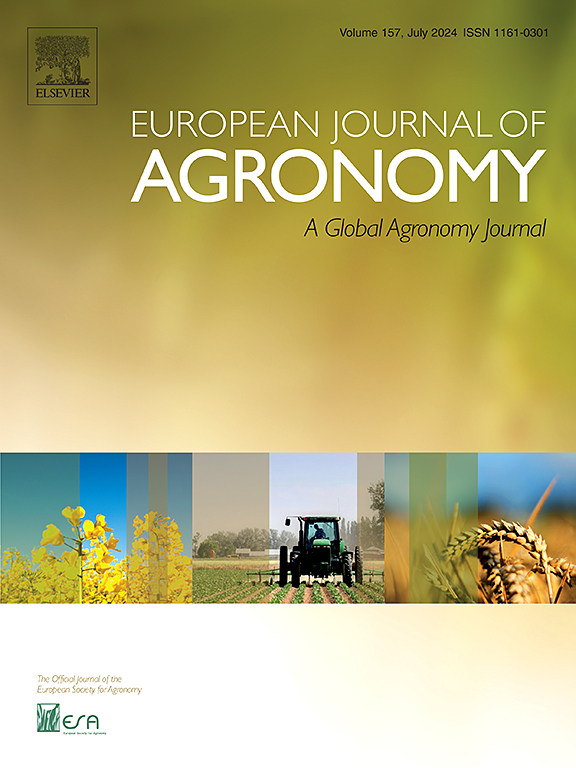Novel termination techniques of winter cover crops in the vineyard: Effects on physiology and performance of Pinot Noir and Malvasia di Candia aromatica grapevines
IF 5.5
1区 农林科学
Q1 AGRONOMY
引用次数: 0
Abstract
A current significant vineyard challenge is how other-than tillage soil management solutions can be implemented without incurring in major competition for water and nutrients with the consociated grapevines. Therefore, a three-year study was carried at two hilly sites (Sartori and Ottina) in Northern Italy to evaluate the impact of two novel winter cover crop terminations (interrow rolling, R, and sub-row mulching, SRM) on vine physiology and performance as compared to standard practice, either alternate tilled-grassed interrow and/or green manuring (GM). Moreover, at the Ottina site, cover crop sowing used two different seed mixtures: the cereal based Humusfert (HF) and the legume based Nitrofert (NF). Each season, in summer, soil and vine water status were measured as soil saturation degree (θs/θsat), pre-dawn (ΨPD) and midday leaf water potential (ΨMD), whereas gas exchange was monitored as leaf assimilation (A) and stomatal conductance (gs). At both sites, for data pooled over years, the amount of rolled dry biomass was lower than 650 g m−2 and R did not result in any significant variation of water status, gas exchange and vine performance versus the standard practice. Vice versa, at the Sartori site, the amount of mulched biomass under the row was quite abundant (1.517 g m−2 dry weight) and effective for weed suppression. SRM also maintained less negative ΨPD in the warmest part of 2022 and 2023 seasons without, however, greatly impacting leaf water status, gas exchange and vine performances. At Ottina, SRM assured, for data pooled over years, higher total soluble solids (TSS) and malic acid and lower pH than R suggesting that sugar accumulation and acid degradation were partially decoupled. At the same site, NF allowed to increase yield without any concurrent change in vigor with a consequent ripening delay in terms of lower TSS, pH and anthocyanins, and higher tartaric acid at harvest, a sought effects under a global warming scenario. It is also practically relevant that HF lowered berry [K] significantly vs. NF suggesting that it might be used as an additional control tool to limit K accumulation into the berries and, eventually, wine pH. Overall, while SRM had better performance than R in terms of weed suppression, soil water status and berry ripening, results can vary as a function of the type of seed mixture which, in turn, closely interacts with specific environmental conditions.
葡萄园冬季覆盖作物终止新技术:对黑皮诺和坎地玛尔瓦西亚葡萄生理和生产性能的影响
目前葡萄园面临的一个重大挑战是,如何实施耕作以外的土壤管理解决方案,而不会与相关葡萄藤在水和养分方面产生重大竞争。因此,在意大利北部的两个丘陵地区(Sartori和Ottina)进行了一项为期三年的研究,以评估两种新型冬季覆盖作物终止(行间滚动,R和分行覆盖,SRM)对葡萄生理和性能的影响,并与标准做法进行比较,交替耕草行间和/或绿色施肥(GM)。此外,在Ottina站点,覆盖作物播种使用了两种不同的混合种子:以谷物为基础的Humusfert (HF)和以豆类为基础的Nitrofert (NF)。在夏季,每个季节,土壤和藤本植物的水分状况以土壤饱和度(θs/θsat)、黎明前(ΨPD)和正午叶片水势(ΨMD)来测量,而气体交换以叶片同化(A)和气孔导度(gs)来监测。在这两个地点,对于多年来汇集的数据,滚动干生物量的量低于650 g m−2,与标准实践相比,R不会导致水状态、气体交换和藤蔓性能的任何显着变化。反之,在Sartori场地,行下覆盖生物量相当丰富(1.517 g m−2干重),有效抑制杂草。在2022年和2023年最温暖的部分,SRM也保持了较小的负ΨPD,但没有对叶片水分状况、气体交换和藤蔓性能产生很大影响。在Ottina, SRM保证,根据多年收集的数据,较高的总可溶性固体(TSS)和苹果酸以及低于R的pH值表明糖积累和酸降解部分解耦合。在同一地点,NF可以在没有任何活力变化的情况下增加产量,从而在收获时降低TSS、pH和花青素,提高酒石酸的成熟延迟,这是在全球变暖情景下寻求的效果。与NF相比,HF显著降低浆果[K]也具有实际意义,这表明它可能被用作限制钾在浆果中的积累并最终限制酒ph的额外控制工具。总体而言,尽管SRM在抑制杂草、土壤水分状况和浆果成熟方面的表现优于R,但结果可能因种子混合物类型的函数而异,而种子混合物类型又与特定环境条件密切相互作用。
本文章由计算机程序翻译,如有差异,请以英文原文为准。
求助全文
约1分钟内获得全文
求助全文
来源期刊

European Journal of Agronomy
农林科学-农艺学
CiteScore
8.30
自引率
7.70%
发文量
187
审稿时长
4.5 months
期刊介绍:
The European Journal of Agronomy, the official journal of the European Society for Agronomy, publishes original research papers reporting experimental and theoretical contributions to field-based agronomy and crop science. The journal will consider research at the field level for agricultural, horticultural and tree crops, that uses comprehensive and explanatory approaches. The EJA covers the following topics:
crop physiology
crop production and management including irrigation, fertilization and soil management
agroclimatology and modelling
plant-soil relationships
crop quality and post-harvest physiology
farming and cropping systems
agroecosystems and the environment
crop-weed interactions and management
organic farming
horticultural crops
papers from the European Society for Agronomy bi-annual meetings
In determining the suitability of submitted articles for publication, particular scrutiny is placed on the degree of novelty and significance of the research and the extent to which it adds to existing knowledge in agronomy.
 求助内容:
求助内容: 应助结果提醒方式:
应助结果提醒方式:


